| Solar eclipse of November 23, 1965 | |
|---|---|
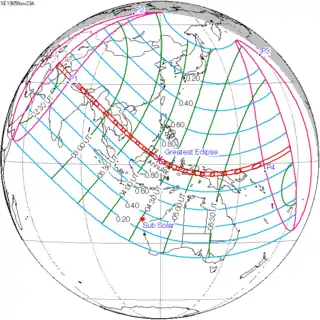 Map | |
| Type of eclipse | |
| Nature | Annular |
| Gamma | 0.3906 |
| Magnitude | 0.9656 |
| Maximum eclipse | |
| Duration | 242 sec (4 m 2 s) |
| Coordinates | 1°42′N 119°48′E / 1.7°N 119.8°E |
| Max. width of band | 134 km (83 mi) |
| Times (UTC) | |
| Greatest eclipse | 4:14:51 |
| References | |
| Saros | 132 (43 of 71) |
| Catalog # (SE5000) | 9433 |
An annular solar eclipse occurred on November 23, 1965. A solar eclipse occurs when the Moon passes between Earth and the Sun, thereby totally or partly obscuring the image of the Sun for a viewer on Earth. An annular solar eclipse occurs when the Moon's apparent diameter is smaller than the Sun's, blocking most of the Sun's light and causing the Sun to look like an annulus (ring). An annular eclipse appears as a partial eclipse over a region of the Earth thousands of kilometres wide. Annularity was visible from the Soviet Union (today's eastern Turkmenistan, southern Uzbekistan and southwestern Tajikistan), Afghanistan, Pakistan, India, China, Nepal (including the capital city Kathmandu), southwestern Sikkim (now merged with India), Burma, southwestern tip of Sainyabuli Province in Laos, Cambodia, South Vietnam (now belonging to Vietnam), Spratly Islands, Brunei, Malaysia, Indonesia, the Territory of Papua New Guinea (today's Papua New Guinea), and Gilbert and Ellice Islands (the part now belonging to Kiribati). 8 of the 14 eight-thousanders—Dhaulagiri, Annapurna, Manaslu, Shishapangma, Cho Oyu, Everest, Lhotse and Makalu, as well as the highest peak of Oceania, Puncak Jaya, lie in the path of annularity.
Related eclipses
Solar eclipses of 1964–1967
This eclipse is a member of a 1964–1967 series at alternating nodes every 6 synodic months.
Note: Partial solar eclipses on January 14, 1964 and July 9, 1964 belong to the previous lunar year set.
| Solar eclipse series sets from 1964–1967 | ||||||
|---|---|---|---|---|---|---|
| Ascending node | Descending node | |||||
| Saros | Map | Gamma | Saros | Map | Gamma | |
| 117 | 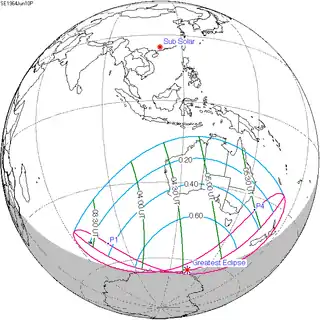 1964 June 10 Partial | −1.13926 | 122 | 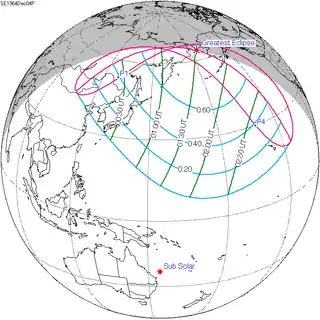 1964 December 4 Partial | 1.11929 | |
| 127 |  1965 May 30 Total | −0.42251 | 132 |  1965 November 23 Annular | 0.39061 | |
| 137 | 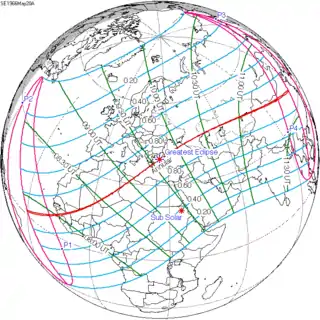 1966 May 20 Annular | 0.34672 | 142 |  1966 November 12 Total | −0.33001 | |
| 147 | 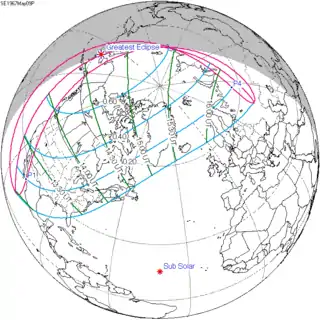 1967 May 9 Partial | 1.14218 | 152 | 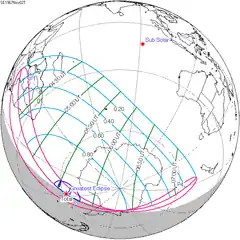 1967 November 2 Total (non-central) | −1.00067 | |
Saros 132
This eclipse is a part of Saros cycle 132, repeating every 18 years, 11 days, containing 71 events. The series started with partial solar eclipse on August 13, 1208. It contains annular eclipses from March 17, 1569 through March 12, 2146, hybrid on March 23, 2164 and April 3, 2183 and total eclipses from April 14, 2200 through June 19, 2308. The series ends at member 71 as a partial eclipse on September 25, 2470. The longest duration of annular was 6 minutes, 56 seconds on May 9, 1641, and totality will be 2 minutes, 14 seconds on June 8, 2290. All eclipses in this series occurs at the Moon’s descending node.
| Series members 28–50 occur between 1690 and 2100: | ||
|---|---|---|
| 28 | 29 | 30 |
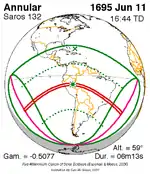 June 11, 1695 |
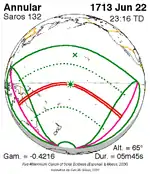 June 22, 1713 |
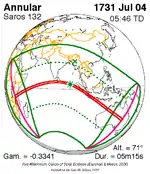 July 4, 1731 |
| 31 | 32 | 33 |
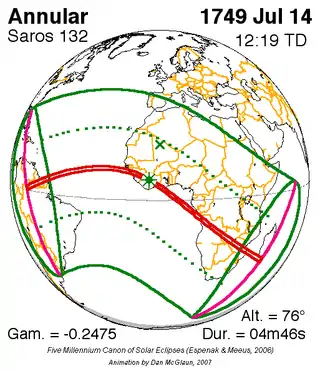 July 14, 1749 |
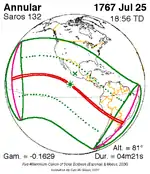 July 25, 1767 |
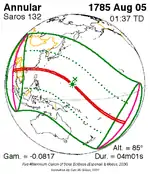 August 5, 1785 |
| 34 | 35 | 36 |
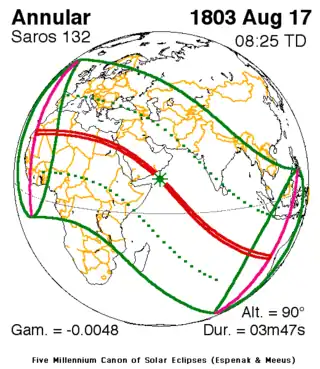 August 17, 1803 |
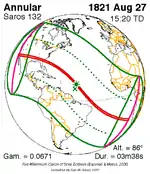 August 27, 1821 |
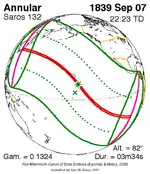 September 7, 1839 |
| 37 | 38 | 39 |
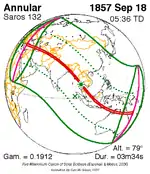 September 18, 1857 |
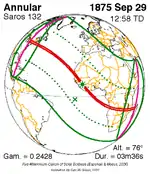 September 29, 1875 |
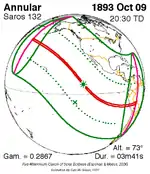 October 9, 1893 |
| 40 | 41 | 42 |
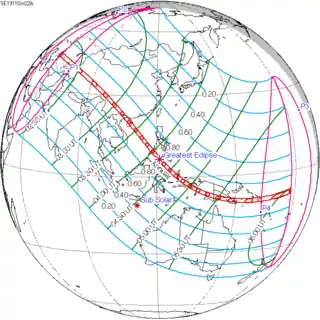 October 22, 1911 |
 November 1, 1929 |
 November 12, 1947 |
| 43 | 44 | 45 |
 November 23, 1965 |
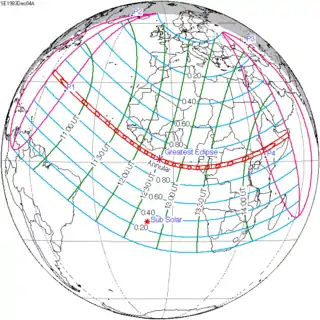 December 4, 1983 |
 December 14, 2001 |
| 46 | 47 | 48 |
 December 26, 2019 |
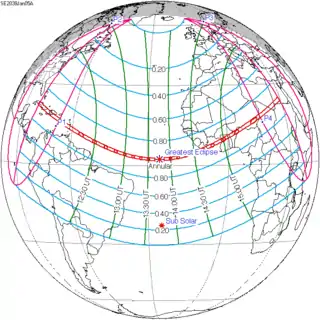 January 5, 2038 |
 January 16, 2056 |
| 49 | 50 | |
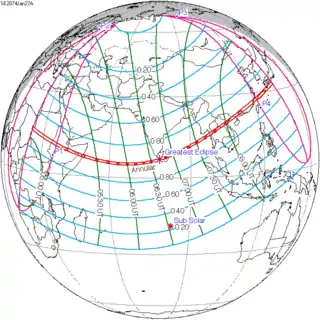 January 27, 2074 |
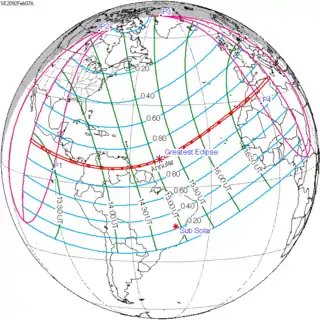 February 7, 2092 | |
Inex series
This eclipse is a part of the long period inex cycle, repeating at alternating nodes, every 358 synodic months (≈ 10,571.95 days, or 29 years minus 20 days). Their appearance and longitude are irregular due to a lack of synchronization with the anomalistic month (period of perigee). However, groupings of 3 inex cycles (≈ 87 years minus 2 months) comes close (≈ 1,151.02 anomalistic months), so eclipses are similar in these groupings.
| Inex series members between 1901 and 2100: | ||
|---|---|---|
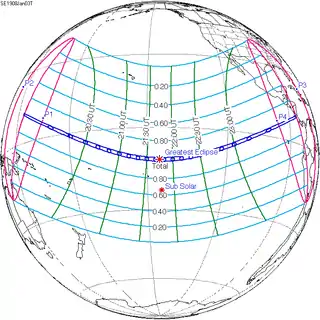 January 3, 1908 (Saros 130) |
 December 13, 1936 (Saros 131) |
 November 23, 1965 (Saros 132) |
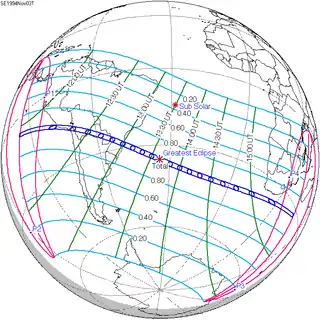 November 3, 1994 (Saros 133) |
 October 14, 2023 (Saros 134) |
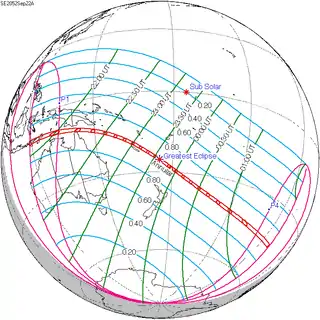 September 22, 2052 (Saros 135) |
 September 3, 2081 (Saros 136) |
||
Metonic series
The metonic series repeats eclipses every 19 years (6939.69 days), lasting about 5 cycles. Eclipses occur in nearly the same calendar date. In addition, the octon subseries repeats 1/5 of that or every 3.8 years (1387.94 days). All eclipses in this table occur at the Moon's descending node.
| 22 eclipse events between September 12, 1931 and July 1, 2011. | ||||
|---|---|---|---|---|
| September 11-12 | June 30-July 1 | April 17-19 | February 4-5 | November 22-23 |
| 114 | 116 | 118 | 120 | 122 |
 September 12, 1931 |
 June 30, 1935 |
 April 19, 1939 |
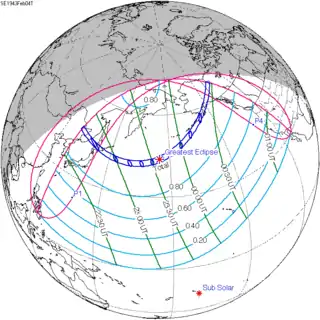 February 4, 1943 |
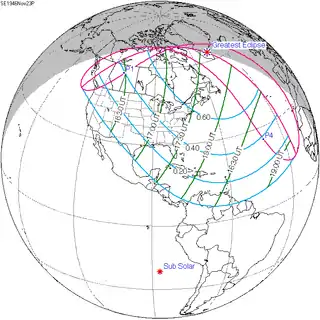 November 23, 1946 |
| 124 | 126 | 128 | 130 | 132 |
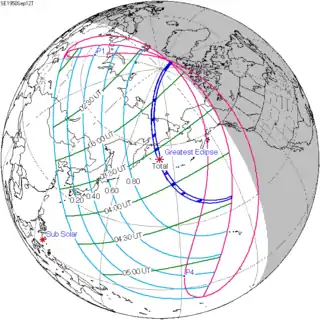 September 12, 1950 |
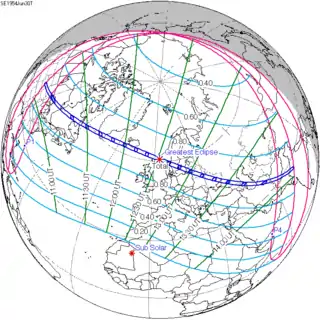 June 30, 1954 |
 April 19, 1958 |
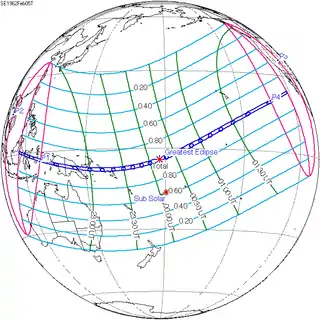 February 5, 1962 |
 November 23, 1965 |
| 134 | 136 | 138 | 140 | 142 |
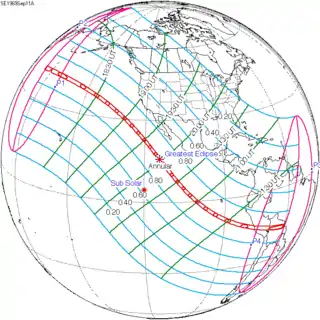 September 11, 1969 |
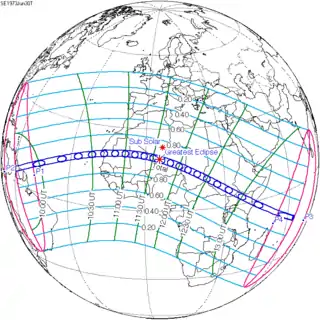 June 30, 1973 |
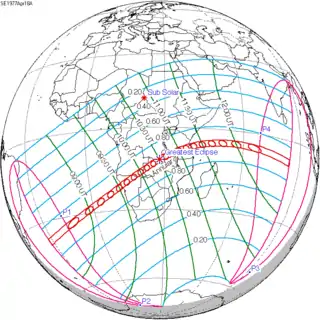 April 18, 1977 |
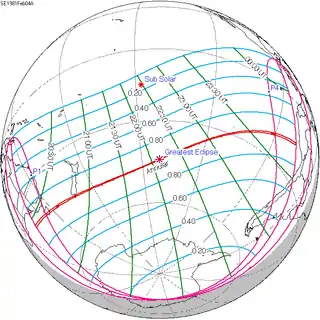 February 4, 1981 |
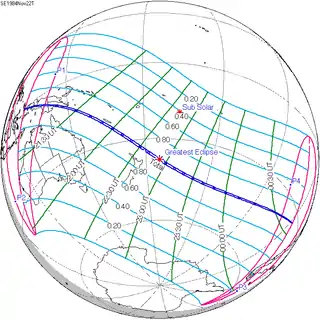 November 22, 1984 |
| 144 | 146 | 148 | 150 | 152 |
 September 11, 1988 |
 June 30, 1992 |
 April 17, 1996 |
 February 5, 2000 |
 November 23, 2003 |
| 154 | 156 | |||
 September 11, 2007 |
 July 1, 2011 | |||
Notes
References
- Earth visibility chart and eclipse statistics Eclipse Predictions by Fred Espenak, NASA/GSFC
.jpg.webp)

